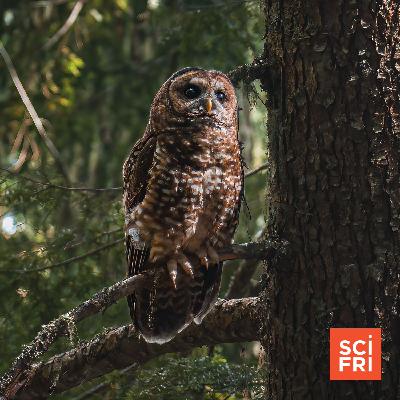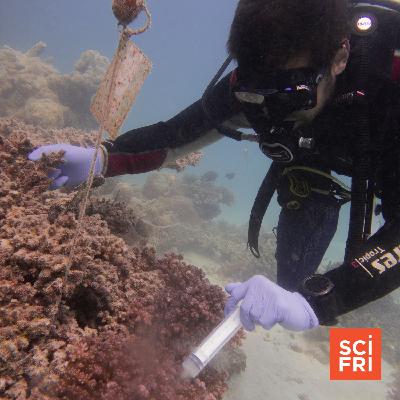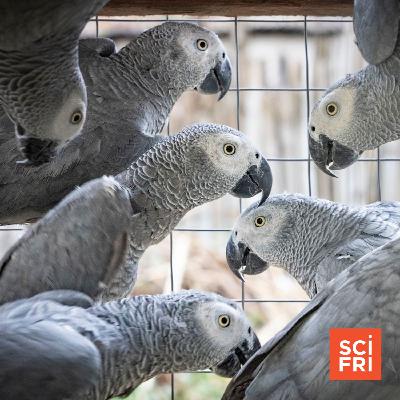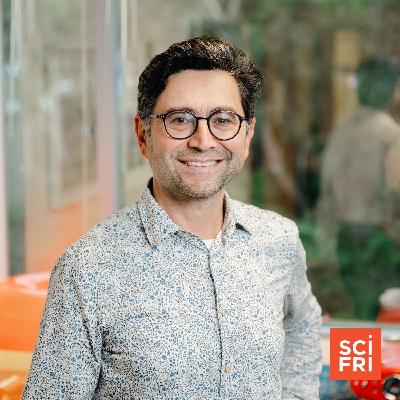Discover Science Friday
Science Friday

Science Friday
Author: Science Friday and WNYC Studios
Subscribed: 154,615Played: 4,182,662Subscribe
Share
© Science Friday
Description
Covering the outer reaches of space to the tiniest microbes in our bodies, Science Friday is the source for entertaining and educational stories about science, technology, and other cool stuff.
1190 Episodes
Reverse
There’s an enormous buildout of data centers underway across the country to fuel the AI boom. Hundreds of billions of dollars have already been spent on data centers, with talk of spending trillions more. And these data centers use a lot of power: According to the Times Picuayune, Meta’s new data center under construction in Louisiana will require nearly three times the power that New Orleans uses in a year. Residents across the country have taken note, and rising utility rates have become an issue in some recent elections.Casey Crownhart, senior climate reporter at MIT Technology Review, has been studying the costs and impacts of the data center boom. She joins Host Ira Flatow for an update on the latest.Guest: Casey Crownhart is a senior climate reporter at MIT Technology Review, based in New York, NY.Transcripts for each episode are available within 1-3 days at sciencefriday.com.
Subscribe to this podcast. Plus, to stay updated on all things science, sign up for Science Friday's newsletters.
You might think about bats as flitting around in the dark and hunting insects, but some species feed on fruits or flowers—and play an important role as pollinators. One place that role is crucial is in the relationship between bats and agave plants. Bat conservationist Kristen Lear joins Host Ira Flatow to describe efforts to restore agaves in the Southwest and Mexico, which has consequences for bats, for the ecosystems around the agave, and for your liquor cabinet, since agave is the source of drinks like tequila and mezcal.Plus, journalist Dan Fagin joins Ira to discuss his recent New York Times article on a new technology that is letting researchers follow individual monarch butterflies over the course of a thousand-mile migration. Guests:Dr. Kristen Lear is director of the Agave Restoration Initiative at Bat Conservation International, based in Austin, Texas.Dan Fagin is a science journalist and the director of the Science, Health & Environmental Reporting Program at New York University.Transcripts for each episode are available within 1-3 days at sciencefriday.com.
Subscribe to this podcast. Plus, to stay updated on all things science, sign up for Science Friday's newsletters.
The spotted owl has been a conservation flashpoint for more than 30 years. While habitat loss has been their historic foe, their most recent threat comes from within the owl family tree: the barred owl. Barred owls have expanded into the Pacific Northwest and are now outcompeting spotted owls for food and habitat. The U.S. Fish and Wildlife Service has put forth a strategy that some experts say is the only way to save the spotted owl, and it could involve killing hundreds of thousands of barred owls.Ecologist and spotted owl expert Rocky Gutierrez joins Host Flora Lichtman to break down the plan, and explain how we got to this point.Guest: Dr. R.J. “Rocky” Gutierrez is an owl ecologist and professor emeritus at the University of Minnesota. He’s now based in Humboldt County, California.Transcripts for each episode are available within 1-3 days at sciencefriday.com.
Subscribe to this podcast. Plus, to stay updated on all things science, sign up for Science Friday's newsletters.
A team of scientists is trying to jumpstart a global conservation movement, on par with efforts to save the rainforests or protect the oceans. But it might be even more ambitious because the target of their quest is invisible, everywhere, and mostly something we try to hand-sanitize away: microbes.So how do you conserve something that is everywhere and in everything? And why do microbes need protecting to begin with? Host Flora Lichtman digs into it with microbial ecologist Jack Gilbert, who is leading this charge. They chat about the thinking behind microbe conservation plans, and why some scientists are hesitant to jump onboard.Guest: Dr. Jack Gilbert is a microbial ecologist at the Scripps Institution of Oceanography and co-chair of the International Union for Conservation of Nature’s Species Survival Commission’s Microbial Conservation Specialist Group. Transcripts for each episode are available within 1-3 days at sciencefriday.com.
Subscribe to this podcast. Plus, to stay updated on all things science, sign up for Science Friday's newsletters.
When we try to commune with nature, many of us turn toward the living: a walk in the woods among swaying trees, chirping birds, blooming flowers.But earth scientist Anjana Khatwa says not to overlook the inanimate—don’t sleep on rocks. She joins Host Flora Lichtman to talk about her love for rocks beyond the scientific and her new book, The Whispers of Rock.Read an excerpt from The Whispers of Rock: The Stories That Stone Tells about Our World and Our Lives.Guest: Dr. Anjana Khatwa is a geologist and author of The Whispers of Rock: The Stories That Stone Tells about Our World and Our Lives.Transcripts for each episode are available within 1-3 days at sciencefriday.com.
Subscribe to this podcast. Plus, to stay updated on all things science, sign up for Science Friday's newsletters.
Each year, the Ig Nobel Prizes recognize scientific research that first makes you laugh, then makes you think. For instance, researchers who investigated the pizza preferences of lizards on the island of Togo. Or a man who kept track of his fingernail growth for 35 years.As is Thanksgiving tradition, we’re sharing highlights from this year’s Ig Nobels on Science Friday. Annals of Improbable Research editor Marc Abrahams acts as master of ceremonies for the 35th First Annual Ig Nobel Prizes, which include 10 awards, several 24-second scientific lectures, and a mini-opera about indigestion.Guest: Marc Abrahams is the editor and co-founder of Annals of Improbable Research and the founder and master of ceremonies for the Ig Nobel Prize Ceremony in Cambridge, Massachusetts.Transcripts for each episode are available within 1-3 days at sciencefriday.com.
Subscribe to this podcast. Plus, to stay updated on all things science, sign up for Science Friday's newsletters.
A good workout can make you feel triumphant. And even if that isn’t your relationship with exercise, you’ve probably heard that working out can lift your mood, fight depression, and make you more resilient when life knocks back. But why exactly does exercise improve mental health? Is it all about those endorphins? Does the type or duration of a workout matter if you’re looking for a mental wellness boost?To help answer those questions and more, Host Flora Lichtman talks with Eduardo Esteban Bustamante and Jack Raglin, who both study the relationship between physical activity and mental health.Guests: Dr. Eduardo Esteban Bustamante studies the link between physical activity and mental health in kids as the director of the Healthy Kids Lab at the University of Illinois, Chicago.Dr. Jack Raglin studies exercise and sports science as a professor of kinesiology at Indiana University.Transcripts for each episode are available within 1-3 days at sciencefriday.com.
Subscribe to this podcast. Plus, to stay updated on all things science, sign up for Science Friday's newsletters.
It’s a wonderful time of the year: squash, pumpkin, and gourd season. But how do those giant, award-winning pumpkins grow so big? And what’s the difference between a gourd and a squash? In a conversation from 2023, Ira talks with Dr. Chris Hernandez, director of the University of New Hampshire’s squash, pumpkin, and melon breeding program to explore all things winter squash and answer listener questions.Guests: Dr. Chris Hernandez is an assistant professor of Plant Breeding at the University of New Hampshire in Durham, New Hampshire.Dan Souza is co-Editor of Cook’s Science: How to Unlock Flavor in 50 of our Favorite Ingredients (Cook’s Illustrated, 2016). He’s based in Boston, Massachusetts.Transcript is available at sciencefriday.com.
Subscribe to this podcast. Plus, to stay updated on all things science, sign up for Science Friday's newsletters.
Have you ever gotten to the end of, say, a jar of peanut butter and wondered if it should go in trash or recycling? If it’s worth rinsing out? And where will it actually end up?Journalist Alexander Clapp had those same questions, and went to great lengths to answer them—visiting five continents to chronicle how our trash travels. Along the way, he discovered a multibillion-dollar trash trade run by shady waste brokers, and a global industry powered by slimy spoons, crinkled plastic bags, and all the other stuff we throw away. It’s a putrid business that we’re a part of, and many of us know little about.In a conversation from February, Host Flora Lichtman speaks with Clapp about the garbage business and his new book Waste Wars: The Wild Afterlife Of Your Trash.Guest: Alexander Clapp is a journalist and author of Waste Wars: The Wild Afterlife Of Your Trash. He’s based in Athens, Greece.Transcript is available at sciencefriday.com.
Subscribe to this podcast. Plus, to stay updated on all things science, sign up for Science Friday's newsletters.
Twenty years ago, a young oncologist started journaling to process his experience treating cancer patients. That cathartic act became the Pulitzer Prize-winning book The Emperor of All Maladies: A Biography of Cancer.Fifteen years after the book was published, how has our understanding of preventing and treating cancer changed? Host Flora Lichtman is joined by author Siddhartha Mukherjee to talk about what we now understand about screening, environmental risks, and rising cancer rates in young people.Read an excerpt of the new chapters added to The Emperor of Maladies on the 15th anniversary of the book’s publication. This headline has been corrected from "Multi-Headed" to "Many-Headed" to accurately reflect Siddhartha Mukherjee's statement.Guest: Dr. Siddhartha Mukherjee is a cancer physician and an associate professor of medicine at Columbia University.Transcripts for each episode are available within 1-3 days at sciencefriday.com.
Subscribe to this podcast. Plus, to stay updated on all things science, sign up for Science Friday's newsletters.
African grey parrots are internet stars. It’s easy to see why—the charismatic birds sing, tell jokes, and sling profanities. But how do the endangered birds get from African forests to your feed? Wildlife crime reporter Rene Ebersole joins Host Flora Lichtman to describe her investigation into the global parrot trade, and the black market for wild African greys that is threatening their existence.Guest: Rene Ebersole is Editor In Chief at Wildlife Investigative Reporters and Editors (WIRE).Transcripts for each episode are available within 1-3 days at sciencefriday.com.
Subscribe to this podcast. Plus, to stay updated on all things science, sign up for Science Friday's newsletters.
After years of getting your emails and phone calls, we know that SciFri listeners are in the 99th percentile when it comes to nerdy knowledge. We’re putting your fact retention skills to the test with the first ever Super Food Science Excellence Trivia Blowout (SFSETBO).Host Flora Lichtman teams up with trivia kingpin Mangesh Hattikudur, co-host of the podcast “Part-Time Genius,” to quiz one lucky listener on her food science knowledge.Guest: Mangesh Hattikudur is the co-host of “Part-Time Genius” and co-founder of Kaleidoscope.Transcripts for each episode are available within 1-3 days at sciencefriday.com.
Subscribe to this podcast. Plus, to stay updated on all things science, sign up for Science Friday's newsletters.
Some animals have a very different relationship to aging than we do: They don’t get cancer, they never go through menopause, and they live absurdly long lives. For instance, one bat species can live for more than 40 years, which may not sound like very long but that’s about nine times longer than expected based on its size. For comparison, if we aged on that scale, we’d live for hundreds of years. These bats aren’t the only animal super-agers—there’s a whole menagerie of them.So what’s their secret? And can we learn anything from them that might help us live longer, healthier lives? Host Flora Lichtman talks with longevity researchers Vera Gorbunova and Juan Manuel Vazquez about what animals are teaching us.Guests:Dr. Vera Gorbunova is a biologist and professor at the University of Rochester, and a co-director of the Rochester Aging Research Center.Dr. Juan Manuel Vazquez is a biologist and assistant professor at Pennsylvania State University studying the evolution of aging.Transcripts for each episode are available within 1-3 days at sciencefriday.com.
Subscribe to this podcast. Plus, to stay updated on all things science, sign up for Science Friday's newsletters.
Proteins are crucial for life. They're made of amino acids that “fold” into millions of different shapes. And depending on their structure, they do radically different things in our cells. For a long time, predicting those shapes for research was considered a grand biological challenge.But in 2020, Google’s AI lab DeepMind released Alphafold, a tool that was able to accurately predict many of the structures necessary for understanding biological mechanisms in a matter of minutes. In 2024, the Alphafold team was awarded a Nobel Prize in chemistry for the advance.Five years later after its release, Host Ira Flatow checks in on the state of that tech and how it’s being used in health research with John Jumper, one of the lead scientists responsible for developing Alphafold.Guest: John Jumper, scientist at Google Deepmind and co-recipient of the 2024 Nobel Prize in chemistry.Transcripts for each episode are available within 1-3 days at sciencefriday.com.
Subscribe to this podcast. Plus, to stay updated on all things science, sign up for Science Friday's newsletters.
If you’ve heard the hammering of a woodpecker in the woods, you might have wondered how the birds can be so forceful. What does it take to whack your head against a tree repeatedly, hard enough to drill a hole? A team of researchers wondered that too and set out to investigate, by putting tiny muscle monitors on eight downy woodpeckers and recording them with high-speed video as they pecked away in the lab.Integrative organismal biologist Nick Antonson, co-author of a report on the work, joins Host Flora Lichtmen to peck away at the mystery.Plus, you can take two ant eggs with the exact same genes, and one can grow up to be a queen, the other a worker. Neuroscientist and evolutionary biologist Daniel Kronauer joins Flora to share recent research into how an ant becomes a queen.Guests: Dr. Nick Antonson is an NSF postdoctoral research fellow in the department of ecology, evolution, and organismal biology at Brown University.Dr. Daniel Kronauer is the Stanley S. and Sydney R. Shuman Professor in the Laboratory of Social Evolution and Behavior at The Rockefeller University in New York.Transcripts for each episode are available within 1-3 days at sciencefriday.com.
Subscribe to this podcast. Plus, to stay updated on all things science, sign up for Science Friday's newsletters.
Our memories make us who we are—just ask Barbra Streisand. But despite the lyrics in many popular songs, memories aren’t frozen in time. When we call them up, the details shift and change. And neuroscience research shows that we might be able to take that a step further—to manipulate our memories and even implant false ones.Neuroscientist Steve Ramirez joins Host Ira Flatow to explain how memory manipulation could revolutionize the way we treat brain disorders. They also discuss Ramirez’s book, How to Change a Memory: One Neuroscientist's Quest to Alter the Past, and how the sudden death of his friend and scientific collaborator made him rethink the role of memory.Guest: Dr. Steve Ramirez is an associate professor of psychology and brain sciences at Boston University and the author of How to Change a Memory.Transcripts for each episode are available within 1-3 days at sciencefriday.com.
Subscribe to this podcast. Plus, to stay updated on all things science, sign up for Science Friday's newsletters.
Bearded vultures build giant, elaborate nests that are passed down from generation to generation. And according to a new study, some of these scavengers have collected bits and bobs of human history over the course of centuries. Scientists picked apart 12 vulture nests preserved in Spain and discovered a museum collection’s worth of objects, including a woven sandal that could be more than 700 years old. Host Flora Lichtman talks with study author Ana Belen Marín-Arroyo, an archaeologist who studies ancient humans, about how the nests are giving us a glimpse into vulture culture as well as the lives of the people they lived beside.Guest: Dr. Ana Belen Marín-Arroyo is an archeologist and professor of prehistory at the University of Cantabria in Spain.Transcripts for each episode are available within 1-3 days at sciencefriday.com.
Subscribe to this podcast. Plus, to stay updated on all things science, sign up for Science Friday's newsletters.
The band Phish has toured for over 40 years. One of the draws of their legendary live shows—which can go on for 8 hours—is finding moments of “flow,” when the band members lock into an improvised jam, finding new musical ideas in real time.Phish fans live for these transcendent moments, but so do the musicians—to the point that Mike Gordon, the band’s bass player, is funding scientific research to better understand flow state.Host Flora Lichtman sits down with Mike and his research collaborator, neuroscientist Greg Appelbaum, to unpack their research so far and how it’s helping to inform other neuroscience.Guests:Mike Gordon is bassist and co-founder of the rock band Phish. Dr. Greg Appelbaum is a professor in the department of psychiatry at the University of California, San Diego.Transcripts for each episode are available within 1-3 days at sciencefriday.com.
Subscribe to this podcast. Plus, to stay updated on all things science, sign up for Science Friday's newsletters.
Around 25 years ago, Ardem Patapoutian set out to investigate the fundamental biology behind our sense of touch. Through a long process of gene elimination, he identified a class of sensors in the cell membrane that turn physical pressure into an electrical signal. He changed the game in the field of sensation and perception, and in 2021 shared the Nobel Prize in Physiology or Medicine for his work. He joins Host Flora Lichtman to talk about his research, the odd jobs he worked along the way, and how he found a sense of belonging in science.Guest: Dr. Ardem Patapoutian is a professor and the Presidential Endowed Chair in Neurobiology at the Scripps Research Institute in La Jolla, California. Transcripts for each episode are available within 1-3 days at sciencefriday.com.
Subscribe to this podcast. Plus, to stay updated on all things science, sign up for Science Friday's newsletters.
Over the last five years, billions of people have received at least one dose of a COVID-19 mRNA vaccine. New research has found an unanticipated result of these vaccines: Cancer treatments are more effective for some vaccinated patients, and many live longer than their unvaccinated counterparts. This news comes at a time where the federal government is slashing funding for mRNA research. Host Ira Flatow speaks to lead study author Adam Grippin and vaccine expert Eric Topol.Guests: Dr. Adam Grippin is a radiation oncologist at the MC Anderson Cancer Center in Houston, Texas. Dr. Eric Topol is a cardiologist and genomics professor at the Scripps Research Institute in La Jolla, California.Transcripts for each episode are available within 1-3 days at sciencefriday.com.
Subscribe to this podcast. Plus, to stay updated on all things science, sign up for Science Friday's newsletters.



























what a beautiful poem 💐
🔥🔥🥳🥳 That's amazing
volume zwQarsa
how can I have the transcription?
two people showing closed minds trying to negate another's observations in real life. sheesh, how many times did they say myth. not cool; hard pass listening to them further
why does Flatow drag these discussions down to a simplistic reduction that yields the same trite predetermined formula he wants for publication? why not find out the basis for new information and what makes it more reliable than previous means of measurement? does this recent finding just increase the range of possible values for the Hubble constant? or does it effectively supersede previous calculations?
some editing issues towards the end of this episode, unfortunate because it's such a good one!
I've often wondered if they could crispr a tree to grow faster and larger for lumber purposes. what's the genetic difference between giant bamboo and pine trees.
1:41 . . . Pi merits our irrational attention . . . Now that's "Woke Friday" for ya . . .
6:10 . . . The language of colonialism & imperialism has tainted this field of science ? . . . I used to regularly listen to SF back a decade or two ago before it became so woke. Then Ira started making global warming a part of every episode. It got so tiring. Science used to be interesting & educational. Now for the most part shows like SF are just preachy political. And they never self reflect on the decline.
Who is throwing shade on plants prehistoric or not ?
Not a single thing about how differently the movie would have been made today was discussed in this episode 😂
bro why you talk like that!
I think we shouldn't act like we're outside of nature. Humans are natural, albeit in very different ways sometimes. If we mess up and ecosystem we should be invested in repairing it as best were able. We protect endangered species all the time; it's odd that we'd treat these trees any differently.
The name is Türkiye, not Turkey. They changed their name almost 3 years ago.
between this guy's microphone and his accent I didn't get half of what he said especially at the critical moments.
This is said here by this politician is almost fake news!
Biochar can be used in the making of green concrete, too
this podcast encouraged me to learn other languages
is there any place which i can acsess to text of this interview?